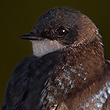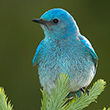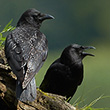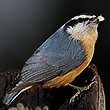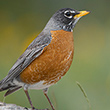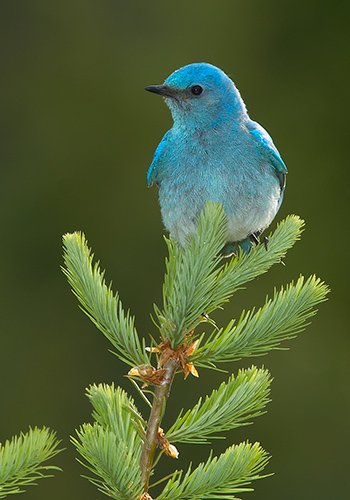
In the Field
Mountain Bluebird on Spring Growth. Findlay Creek, BC, Canada. May 28, 2006.
As most people know, Bluebirds have stunning blue plumage that makes them distinguishable at a glance. But what fewer people know is that the colour of a bluebird is NOT produced by pigments, but by spectrally selective interference in the light reflecting from feather barbs. This interference of light means that the colour of the bird will vary with the angle of illumination and reflection.
Interesting, eh? But why the heck should a photographer care? Well...what this means is that if you like to use flash-fill when photographing birds you have to be REALLY careful with bluebirds. If you use a fill, more often that not the bird's plumage will completely "blow-out", i.e., come out almost pure white! To have any hope of success, you have under-expose your fill pretty dramatically. With this image I pulled the exposure back on the flash fill by a full stop.
Behind the Camera
Mountain Bluebird on Spring Growth. Findlay Creek, BC, Canada. May 28, 2006.
Digital Capture; Compressed RAW (NEF) format; ISO 100.
Nikon D2X with Nikon 200-400 mm f/4G ED-IF AF-S VR lens @ 400 mm (600 mm equivalent with digital conversion factor) supported on Gitzo 1348 carbon fibre tripod with Wimberley head; SB-800 flash (fill) with Better Beamer Flash Extender mounted on Really Right Stuff flash bracket. VR turned to "On" and in "Normal" mode.
1/80s @ f71; -0.3 stop compensation from matrix-metered exposure setting; balanced i-TTL flash exposure with -1.0 stop compensation on SB-800.
At the Computer
Mountain Bluebird on Spring Growth. Findlay Creek, BC, Canada. May 28, 2006.
Details to follow.
Conservation
Mountain Bluebird on Spring Growth. Findlay Creek, BC, Canada. May 28, 2006.
Ten percent of the revenue generated by this image will be donated to Wildsight.
Species Status in Canada*: This species is not designated as at risk.
The Mountain Bluebird (Sialia currucoides) is a brilliantly coloured thrush found over much of western North America. Despite its name, it is NOT limited in distribution to mountain regions. In the early 1900's Mountain Bluebird populations plummeted due to loss of nesting habitat (natural cavities) due to the introduction of alien species, including House Sparrows and Starlings. An aggressive conservation effort in the form of the introduction of species-specific nest boxes worked and today bluebirds are common again.
This male Mountain Bluebird was photographed in the Columbia Valley of the East Kootenays. Many ecosystems within the Columbia Valley face development pressure, including pressure from logging operations. While Mountain Bluebirds are not directly threatened in the Columbia Valley, they do, of course, need appropriate habitat in order to continue to thrive. Wildsight is an effective conservation organization that protects biodiversity and promotes sustainable communities in Canada's Columbia and Rocky Mountains. Support for Wildsight, through donation or becoming a member, will help ensure that they remain effective in their efforts to conserve threatened or endangered species and ecosystems.
*as determined by COSEWIC: The Committee on the Status of Endangered Wildlife in Canada



















